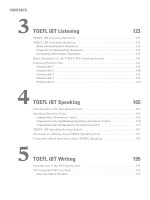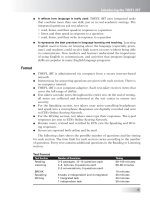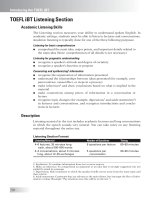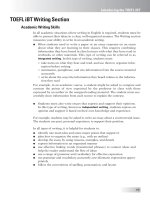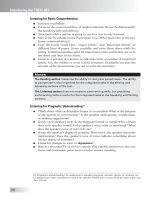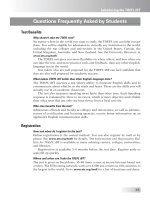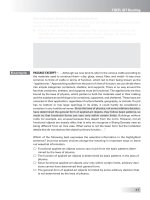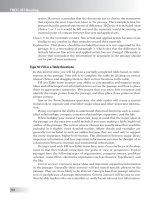The official guide to the toefl ibt third edition part 17 potx
Bạn đang xem bản rút gọn của tài liệu. Xem và tải ngay bản đầy đủ của tài liệu tại đây (103.2 KB, 7 trang )
The creation of a labor force that was accustomed to working in factories did not
occur easily. Before the rise of the factory, artisans had worked within the home. Ap-
prentices were considered part of the family, and masters were responsible not only
for teaching their apprentices a trade but also for providing them some education and
for supervising their moral behavior. Journeymen knew that if they perfected their
skill, they could become respected master artisans with their own shops. Also, skilled
artisans did not work by the clock, at a steady pace, but rather in bursts of intense
labor alternating with more leisurely time.
2. Which of the sentences below best expresses the essential information in the
highlighted sentence in the passage?
Incorrect
answer choices change the mean-
ing in important ways or leave out essential information.
ɕ
Masters demanded moral behavior from apprentices but often treated them
irresponsibly.
ɕ
The responsibilities of the master to the apprentice went beyond the teaching
of a trade.
ɕ
Masters preferred to maintain the trade within the family by supervising and
educating the younger family members.
ɕ
Masters who trained members of their own family as apprentices demanded
excellence from them.
The factory changed that. Goods produced by factories were not as finished or elegant
as those done by hand, and pride in craftsmanship gave way to the pressure to in-
crease rates of productivity. The new methods of doing business involved a new and
stricter sense of time. Factory life necessitated a more regimented schedule, where
work began at the sound of a bell and workers kept machines going at a constant
pace. At the same time, workers were required to discard old habits, for industrialism
demanded a worker who was alert, dependable, and self-disciplined. Absenteeism
and lateness hurt productivity and, since work was specialized, disrupted the regular
factory routine. Industrialization not only produced a fundamental change in the way
work was organized; it transformed the very nature of work.
3. The word disrupted in the passage is closest in meaning to
ɕ
prolonged
ɕ
established
ɕ
followed
ɕ
upset
103
TOEFL iBT Reading
P
A
R
A
G
R
A
P
H
2
P
A
R
A
G
R
A
P
H
3
TOEFL iBT Reading
104
The first generation to experience these changes did not adopt the new attitudes eas-
ily. The factory clock became the symbol of the new work rules. One mill worker who
finally quit complained revealingly about “obedience to the ding-dong of the bell—
just as though we are so many living machines.” With the loss of personal freedom
also came the loss of standing in the community. Unlike artisan workshops in which
apprentices worked closely with the masters supervising them, factories sharply sep-
arated workers from management. Few workers rose through the ranks to supervisory
positions, and even fewer could achieve the artisan’s dream of setting up one’s own
business. Even well-paid workers sensed their decline in status.
In this newly emerging economic order, workers sometimes organized to protect their
rights and traditional ways of life. Craftworkers such as carpenters, printers, and tai-
lors formed unions, and in 1834 individual unions came together in the National
Trades’ Union. The labor movement gathered some momentum in the decade before
the Panic of 1837, but in the depression that followed, labor’s strength collapsed. Dur-
ing hard times, few workers were willing to strike or engage in collective action. And
skilled craftworkers, who spearheaded the union movement, did not feel a particularly
strong bond with semiskilled factory workers and unskilled laborers. More than a
decade of agitation did finally bring a workday shortened to 10 hours to most indus-
tries by the 1850’s, and the courts also recognized workers’ right to strike, but these
gains had little immediate impact.
4. In paragraph 4, the author includes
the quotation from a mill worker in
order to
ɕ
support the idea that it was difficult
for workers to adjust to working in
factories
ɕ
to show that workers sometimes quit
because of the loud noise made by
factory machinery
ɕ
argue that clocks did not have a use-
ful function in factories
ɕ
emphasize that factories were most
successful when workers revealed
their complaints
5. All of the following are mentioned in
paragraph 4 as consequences of the
new system for workers EXCEPT a
loss of
ɕ
freedom
ɕ
status in the community
ɕ
opportunities for advancement
ɕ
contact among workers who were
not managers
6. The phrase gathered some momen-
tum in the passage is closest in
meaning to
ɕ
made progress
ɕ
became active
ɕ
caused changes
ɕ
combined forces
7. The word spearheaded in the pas-
sage is closest in meaning to
ɕ
led
ɕ
accepted
ɕ
changed
ɕ
resisted
P
A
R
A
G
R
A
P
H
4
P
A
R
A
G
R
A
P
H
5
9. The author identifies political party
loyalties, and disagreements over
tactics as two of several factors that
ɕ
encouraged workers to demand
higher wages
ɕ
created divisions among workers
ɕ
caused work to become more spe-
cialized
ɕ
increased workers’ resentment of the
industrial system
10. The word them in the passage
refers to
ɕ
workers
ɕ
political party loyalties
ɕ
disagreements over tactics
ɕ
agents of opportunity
8. Which of the following statements about the labor movement of the 1800’s is
supported by paragraph 5?
ɕ
It was successful during times of economic crisis.
ɕ
Its primary purpose was to benefit unskilled laborers
ɕ
It was slow to improve conditions for workers.
ɕ
It helped workers of all skill levels form a strong bond with each other.
Workers were united in resenting the industrial system and their loss of status, but
they were divided by ethnic and racial antagonisms, gender, conflicting religious per-
spectives, occupational differences, political party loyalties, and disagreements over
tactics. For them, the factory and industrialism were not agents of opportunity but re-
minders of their loss of independence and a measure of control over their lives. As
United States society became more specialized and differentiated, greater extremes of
wealth began to appear. And as the new markets created fortunes for the few, the fac-
tory system lowered the wages of workers by dividing labor into smaller, less skilled
tasks.
105
TOEFL iBT Reading
Before 1815 manufacturing in the United States had been done in homes or shops by
skilled artisans.
7
As master craftworkers, they imparted the knowledge of their trades
to apprentices and journeymen.
7
In addition, women often worked in their homes
part-time, making finished articles from raw material supplied by merchant capitalists.
7
After 1815 this older form of manufacturing began to give way to factories with
machinery tended by unskilled or semiskilled laborers.
7
Cheap transportation net-
works, the rise of cities, and the availability of capital and credit all stimulated the shift
to factory production.
11. Look at the four squares [
7
] that indicate where the following sentence can be
added to the passage.
This new form of manufacturing depended on the movement of goods to
distant locations and a centralized source of laborers.
Where would the sentence best fit?
P
A
R
A
G
R
A
P
H
6
P
A
R
A
G
R
A
P
H
1
TOEFL iBT Reading
ɕ
Before 1815 manufacturing in the United States had been done in homes or
shops by skilled artisans. This new form of manufacturing depended on the
movement of goods to distant locations and a centralized source of laborers.
As master craftworkers, they imparted the knowledge of their trades to appren-
tices and journeymen.
7
In addition, women often worked in their homes part-
time, making finished articles from raw material supplied by merchant capitalists.
7
After 1815 this older form of manufacturing began to give way to factories with
machinery tended by unskilled or semiskilled laborers.
7
Cheap transportation
networks, the rise of cities, and the availability of capital and credit all stimulated
the shift to factory production.
ɕ
Before 1815 manufacturing in the United States had been done in homes or
shops by skilled artisans.
7
As master craftworkers, they imparted the knowledge
of their trades to apprentices and journeymen.This new form of manufacturing
depended on the movement of goods to distant locations and a centralized
source of laborers. In addition, women often worked in their homes part-time,
making finished articles from raw material supplied by merchant capitalists.
7
After 1815 this older form of manufacturing began to give way to factories with
machinery tended by unskilled or semiskilled laborers.
7
Cheap transportation
networks, the rise of cities, and the availability of capital and credit all stimulated
the shift to factory production.
ɕ
Before 1815 manufacturing in the United States had been done in homes or
shops by skilled artisans.
7
As master craftworkers, they imparted the knowledge
of their trades to apprentices and journeymen.
7
In addition, women often
worked in their homes part-time, making finished articles from raw material sup-
plied by merchant capitalists. This new form of manufacturing depended on the
movement of goods to distant locations and a centralized source of laborers.
After 1815 this older form of manufacturing began to give way to factories with
machinery tended by unskilled or semiskilled laborers.
7
Cheap transportation
networks, the rise of cities, and the availability of capital and credit all stimulated
the shift to factory production.
ɕ
Before 1815 manufacturing in the United States had been done in homes or
shops by skilled artisans.
7
As master craftworkers, they imparted the knowledge
of their trades to apprentices and journeymen.
7
In addition, women often
worked in their homes part-time, making finished articles from raw material
supplied by merchant capitalists.
7
After 1815 this older form of manufacturing
began to give way to factories with machinery tended by unskilled or semiskilled
laborers. This new form of manufacturing depended on the movement of goods
to distant locations and a centralized source of laborers. Cheap transportation
networks, the rise of cities, and the availability of capital and credit all stimulated
the shift to factory production.
106
12. Directions:
Complete the table below by indicating which of the answer choices
describe characteristics of the period before 1815 and which describe character-
istics of the 1815–1850 period.
This question is worth 3 points.
Before 1815 1815–1850
bb
bb
b
Answer Choices
107
TOEFL iBT Reading
1. A united, highly successful labor
movement took shape.
2. Workers took pride in their work-
manship.
3. The income gap between the rich
and the poor increased greatly.
4. Transportation networks began to
decline.
5. Emphasis was placed on following
schedules.
6. Workers went through an extensive
period of training.
7. Few workers expected to own their
own businesses.
PRACTICE SET 5 ANSWERS AND EXPLANATIONS
1.
ᕣ
This is an Inference question asking for an inference that can be supported
by the passage. The correct answer is choice 3, “They were produced with
more concern for quality than for speed of production.”
A number of statements throughout the passage support choice 3. Para-
graph 1 states that “Before 1815 manufacturing in the United States had been
done in homes or shops by skilled artisans . . . After 1815 this older form of
manufacturing began to give way to factories with machinery tended by
unskilled or semiskilled laborers.”
Paragraph 2 states that “Before the rise of the factory . . . skilled artisans
did not work by the clock, at a steady pace, but rather in bursts of intense
labor alternating with more leisurely time.”
Paragraph 3 states, “The factory changed that. Goods produced by factories
were not as finished or elegant as those done by hand, and pride in crafts-
manship gave way to the pressure to increase rates of productivity.”
Taken together, these three statements, about production rates, the rise of
factories after 1815, and the decline of craftsmanship after 1815, support the
inference that before 1815, the emphasis had been on quality rather than on
speed of production. Answer choices 1, 2, and 4 are all contradicted by the
passage.
TOEFL iBT Reading
2.
ᕢ
This is a Sentence Simplification question. As with all of these items, a sin-
gle sentence in the passage is highlighted:
Apprentices were considered part of the family, and masters were responsible not
only for teaching their apprentices a trade but also for providing them some educa-
tion and for supervising their moral behavior.
The correct answer is choice 2. Choice 2 contains all of the essential infor-
mation in the highlighted sentence. The highlighted sentence explains why
(part of the family) and how (education, moral behavior) a master’s responsi-
bility went beyond teaching a trade. The essential information is the fact that
the master‘s responsibility went beyond teaching a trade. Therefore, choice 2
contains all that is essential without changing the meaning of the highlighted
sentence.
Choice 1 changes the meaning of the highlighted sentence by stating that
masters often treated apprentices irresponsibly.
Choice 3 contradicts the essential meaning of the highlighted sentence. The
fact that “Apprentices were considered part of the family . . .” suggests that
they were not actual family members.
Choice 4, like choice 3, changes the meaning of the highlighted sentence by
discussing family members as apprentices.
3.
ᕤ
This is a Vocabulary question. The word being tested is disrupted. It is
highlighted in the passage. The correct answer is choice 4, “upset.” The word
“upset” here is used in the context of “hurting productivity.” When something
is hurt or damaged, it is “upset.”
4.
ᕡ
This is a Factual Information question asking for specific information that
can be found in paragraph 4. The correct answer is choice 1, “support the
idea that it was difficult for workers to adjust to working in factories.” The
paragraph begins by stating that workers did not adopt new attitudes toward
work easily and that the clock symbolized the new work rules. The author
provides the quotation as evidence of that difficulty. There is no indication in
the paragraph that workers quit due to loud noise, so choice 2 is incorrect.
Choice 3 (usefulness of clocks) is contradicted by the paragraph. The factory
clock was “useful,” but workers hated it. Choice 4 (workers complaints as a
cause of a factory’s success) is not discussed in this paragraph.
5.
ᕤ
This is a Negative Factual Information question asking for specific infor-
mation that can be found in paragraph 4. Choice 4, “contact among workers
who were not managers,” is the correct answer. The paragraph explicitly con-
tradicts this by stating that “factories sharply separated workers from man-
agement.” The paragraph explicitly states that workers lost choice 1
(freedom), choice 2 (status in the community), and choice 3 (opportunities
for advancement) in the new system, so those choices are all incorrect.
6.
ᕡ
This is a Vocabulary question. The phrase being tested is “gathered some
momentum.” It is highlighted in the passage. The correct answer is choice 1,
“made progress.” To “gather momentum” means to advance with increasing
speed.
108
7.
ᕡ
This is a Vocabulary question. The word being tested is spearheaded. It is
highlighted in the passage. The correct answer is choice 1, “led.” The head of
a spear leads the rest of the spear, so the craftsworkers who “spearheaded”
this movement led it.
8.
ᕣ
This is a Factual Information question asking for specific information that
can be found in paragraph 5. The correct answer is choice 3, “It was slow to
improve conditions for workers.” The paragraph states, “More than a decade
of agitation did finally bring a workday shortened to 10 hours to most indus-
tries by the 1850’s, and the courts also recognized workers’ right to strike, but
these gains had little immediate impact.” This statement explicitly supports
choice 3. All three other choices are contradicted by the paragraph.
9.
ᕢ
This is a Factual Information question asking for specific information
about a particular phrase in the passage. The phrase in question is high-
lighted in the passage. The correct answer is choice 2, “created divisions
among workers.” The paragraph states (emphasis added): “. . . they (workers)
were divided by ethnic and racial antagonisms, gender, conflicting religious
perspectives, occupational differences, political party loyalties, and disagree-
ments over tactics.” So “political party loyalties and disagreements over tac-
tics” are explicitly stated as two causes of division among workers. The other
choices are not stated and are incorrect.
10.
ᕡ
This is a Reference question. The word being tested is them. It is high-
lighted in the passage. This is a simple pronoun-referent item. The word them
in this sentence refers to those people to whom “the factory and industrialism
were not agents of opportunity but reminders of their loss of independence
and a measure of control over their lives.” Choice 1, “Workers,” is the only
choice that refers to this type of person, so it is the correct answer.
11.
ᕤ
This is an Insert Text question. You can see the four black squares in para-
graph 1 that represent the possible answer choices here.
Before 1815 manufacturing in the United States had been done in homes or shops by
skilled artisans.
7
As master craftworkers, they imparted the knowledge of their trades
to apprentices and journeymen.
7
In addition, women often worked in their homes
part-time, making finished articles from raw material supplied by merchant capitalists.
7
After 1815 this older form of manufacturing began to give way to factories with
machinery tended by unskilled or semiskilled laborers.
7
Cheap transportation net-
works, the rise of cities, and the availability of capital and credit all stimulated the shift
to factory production.
The sentence provided, “This new form of manufacturing depended on the
movement of goods to distant locations and a centralized source of laborers,”
is best inserted at square 4. The inserted sentence refers explicitly to “a new
form of manufacturing.” This “new form of manufacturing” is the one men-
tioned in the sentence preceding square 4, “factories with machinery tended
by unskilled or semiskilled laborers.” The inserted sentence then explains that
this new system depended on “the movement of goods to distant locations
109
TOEFL iBT Reading

